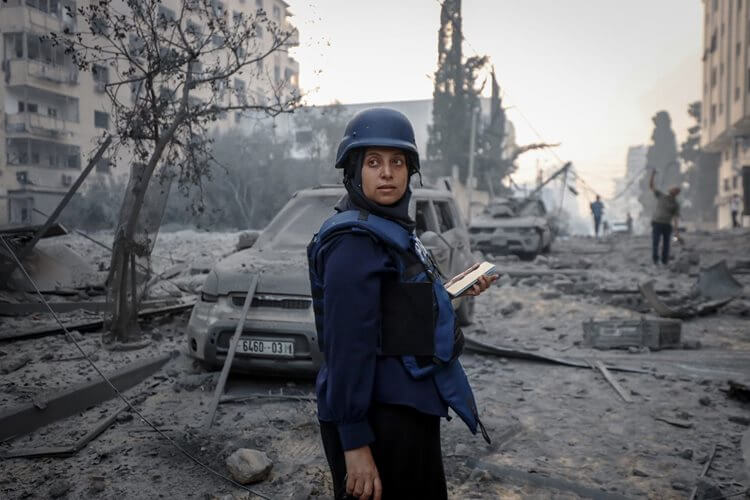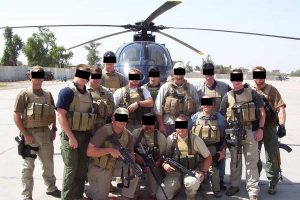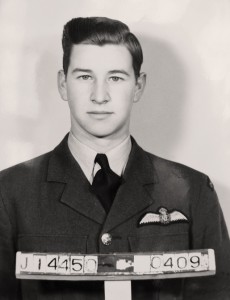
Samar Abu Elouf’s photograph of Mahmoud Ajjour, a nine-year-old Gazan boy who lost his arms in an Israeli attack, has won the 2025 World Press Photo of the Year.
[Samar Abu Elouf/NYT/World Press Photo]
The pool of entries was massive—tens of thousands of photographs from six regions spanning the globe. Yet just three themes came to define the 2025 edition of the 70-year-old competition: conflict, migration and climate change.
“Another way of seeing them is as stories of resilience, family, and community,” said global jury chair Lucy Conticello.
One photograph, the embodiment of resilience, rose above the rest—that of Mahmoud Ajjour, a nine-year-old Palestinian boy who lost both arms after an Israeli attack on Gaza City in March 2024.
Samar Abu Elouf photographed the boy by soft window light for The New York Times, his face the picture of dignity, serenity and resignation. Elouf was herself evacuated from Gaza in December 2023 and was living in the same apartment complex in Doha, Qatar, as Ajjour. It was there where she bonded with other Gazan families and documented some of the wounded seeking treatment.
As his family fled the assault, Ajjour turned back to urge others onward. An explosion severed one of his arms and mutilated the other. The family was evacuated to Qatar where the boy was treated and is now learning to use his feet to write, open doors, and play games on his phone.
“He needs special assistance for most daily activities, such as eating and dressing,” reports the Amsterdam-based photo organization. “Mahmoud’s dream is simple: he wants to get prosthetics and live his life as any other child.”
The United Nations Works and Relief Agency estimates that by December 2024, Gaza had more child amputees per capita than anywhere in the world. The World Health Organization reports that by March 2025, more than 7,000 patients had been evacuated from Gaza for medical treatment in Qatar, Egypt, Jordan and Turkey, among others. Some 11,000 more were still awaiting evacuation.
“Without shying away from the corporeal impacts of war, the photo approaches conflict and statelessness from a human angle.”
– World Press Photo of the Year Jury
A self-taught photographer, Elouf has been documenting daily life, news and the effects of conflict on her homeland since 2010. She has worked for numerous international agencies and entities, including The New York Times, Reuters, NZZ and Middle East Eye.
The jury said the Ajjour photograph “speaks to the long-term costs of war, the silences that perpetuate violence, and the role of journalism in exposing these realities.”
“Without shying away from the corporeal impacts of war, the photo approaches conflict and statelessness from a human angle, shedding light on the physical and psychological traumas civilians have been forced to, and will continue to endure through industrial scale killing and warfare,” it said.
“The Jury found this portrait, with its strong composition and attention to light, to be contemplative, sparking questions about the experiences yet to come for the young wounded boy, about the dehumanization of a region, and about the relentless targeting of journalists in Gaza alongside the continued denial of access to international reporters seeking to expose the realities of this war.”
More than 170 journalists have been confirmed killed in Gaza since 2023, the Committee to Protect Journalists reported in March 2025, after Hossam Shabat, a 23-year-old Al Jazeera reporter, was killed in an Israeli airstrike. It is the deadliest conflict for media workers in recent history, reported The Guardian newspaper.
Some estimates place the toll as high as 208.
“For 15 months, journalists in Gaza have been displaced, starved, defamed, threatened, injured and killed by the Israeli army,” Thibaut Bruttin, director general of Reporters Without Borders, told The Guardian. “Despite these dangers, they have continued to inform the population of the enclave and the world while their foreign colleagues were denied access to the territory.”
UNESCO awarded its 2024 World Press Freedom Prize to the Palestinian journalists of Gaza.

Abu Elouf has worked with numerous international organizations including The New York Times, Reuters, NZZ, and Middle East Eye.
[Amjad Al Fayoumi/World Press Photo]
Founded in the Netherlands in 1955, [The World Press Photo’s] annual contest, exhibitions and website reach millions of people worldwide each year.
Other finalists for the World Press Photo of the Year included Getty photographer John Moore’s photograph of Chinese migrants warming themselves under a cold rain after crossing the U.S.-Mexico border, in Campo, Calif. (Chinese constitute the third-largest immigrant group in the U.S., with encounters between unauthorized Chinese nationals and U.S. Customs and Border Protection at the Mexican border surging from roughly 2,200 in 2022 to 38,200 in 2024; such encounters at the U.S.-Canada border almost doubled from 6,700 to 12,400.)
And Musuk Nolte of Panos Pictures, Bertha Foundation, photographed a young man walking two kilometres across a dry riverbed to bring food to his mother in the Brazilian village of Manacapuru. Her home along the banks of the Solimões River was accessible by boat until prolonged drought linked to climate change left it dry.
World Press Photo is an independent non-profit organization that champions the power of photojournalism and documentary photography to “deepen understanding of the world’s complexities, promote dialogue, and inspire action.”
Founded in the Netherlands in 1955, its annual contest, exhibitions and website reach millions of people worldwide each year. The organization sets industry standards through its rigorous processes.
“Our juries meticulously evaluate each entry in its context, selecting compelling news and documentary photography that resonates globally,” it says. “At a time of misinformation and emerging technologies blurring truth and fiction, World Press Photo stands by human-made photojournalism and its unparalleled impact.”
The 2025 judges reviewed a total of 59,320 photographs submitted by 3,778 photographers from 141 countries. They were judged first by six regional juries. The winners were then chosen by an independent global jury consisting of the regional jury chairs plus the global jury chair. As a result, 30 of this year’s 42 winners were local to the country where they photographed their project.
“The world is not the same as it was in 1955 when World Press Photo was founded,” said executive director Joumana El Zein Khoury. “We live in a time when it is easier than ever to look away, to scroll past, to disengage.
“But these images do not let us do that. They cut through the noise, forcing us to acknowledge what is unfolding, even when it is uncomfortable, even when it makes us question the world we live in—and our own role within it.”
The 2025 World Press Photo exhibition is slated to appear in Canada Aug. 27-Oct. 11, 2025, at the Bonsecours Market in Old Montreal.
Advertisement



















